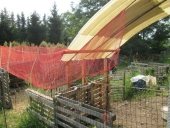Nancy Reading wrote:I find this very interesting Jordan.
So I suppose you just fill the can to a level with whatever oil/fat you have. What did you use for a wick? Just a bit of cloth? I've read that people used to peel common rush for wicks (rush lights) but I've never succeeded in getting any length before the stem snaps. It's either a lost skill or takes a more gentle hand than I have.
Yes, I just used some spent cooking oil. It was a random mix saved in a can that was solid at room temperature. I melted it and poured it in. I burned it about an hour, and it didn't use much, so I don't know if the font is too deep to properly wick. The heat from the flame needs to liquify the fat, so as it burns down things could change.
For the first wick, I just took a few strands of heavy jute twine and twisted them together. It worked fine. Cloth was also widely used as you suggest. They were not too fancy, as the crude fuel fouled rather readily, and they were used up rather quickly as compared to a modern kerosene lantern wick.
I'm not sure of using rushes for wicks. The rush lights with which I am aquatinted were a different affair. They were a simple gravity powered forcep that would grip a single rush that had been treated by basically deep frying it, if I remember correctly, to saturated it with the fat. It burned like a very fast candle, only a few minutes each. I do not have rushes here, so have not tried one. I have wondered about other plants as substitutes, though. I have only seen one rush light that I can remember, but one would be simple to make.








